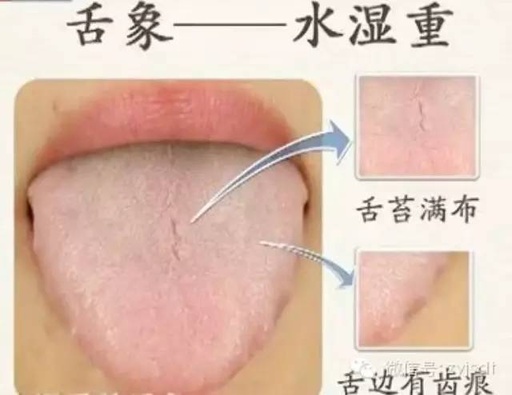
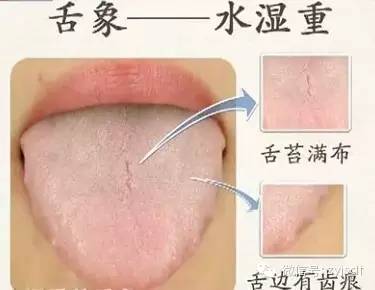
(1) Physical manifestations: Facial (eyelid) swelling, oily complexion, prone to acne, diarrhea, heaviness and fatigue, dry and hard stools, irritability. (2) Causes: Qi deficiency, lack of exercise, consumption of cold drinks, leading to water retention in the body. (3) Solutions: 10 grams each of Hong Dou (Red Bean) and Yi Ren (Job’s Tears), boil in water for 30 minutes, drink as tea to eliminate dampness, suitable for summer. In winter, for cold dampness, use green Hua Jiao (Flower Pepper) to soak feet in boiled water.
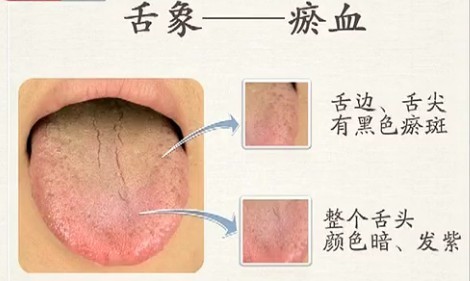
(1) Physical manifestations: Forgetfulness, dry throat, irritable temperament, dry skin, body pain, dull complexion, dark lips, dark circles, dysmenorrhea. (2) Causes: Poor blood circulation, trauma, emotional stress (liver Qi stagnation can easily lead to blood stasis), Qi deficiency, cold exposure. (3) Solutions: 0.5 grams each of San Qi (Notoginseng) and Xi Yang Shen (American Ginseng), powdered and taken with warm water.
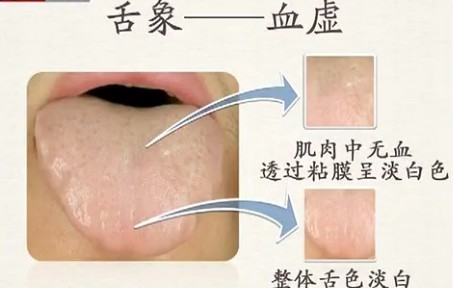
(1) Physical manifestations: Poor memory, poor concentration, poor sleep, prone to insomnia, easy fatigue, sensitivity to wind and cold, warm hands and feet in hot weather, cold hands and feet in cold weather. (2) Causes: Blood loss, poor spleen and stomach function leading to nutrient absorption issues, excessive worry depleting heart and spleen blood. (3) Solutions: 30 grams of Xi Yang Shen (American Ginseng) powdered, 300 grams of Long Yan Rou (Longan Flesh), mix and steam for 4 hours, take one spoon daily with hot water.
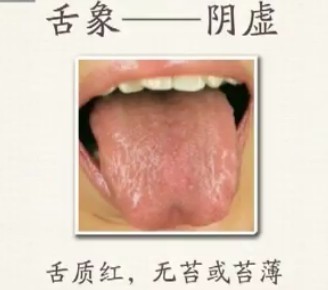
(1) Physical manifestations: Dry eyes, dry mouth and throat, heat in palms and soles, dry stools, dizziness and tinnitus, poor sleep, rapid pulse, preference for cold drinks, irritability, weakness in lower back and knees. (2) Causes: Insufficient body fluids, staying up late, consuming spicy and excessive heat-inducing foods, severe illness. (3) Solutions: 9 grams each of Sheng Di (Rehmannia), Sha Shen (Glehnia), Mai Dong (Ophiopogon), Gou Qi Zi (Goji Berries), 6 grams of Shi Hu (Dendrobium), 3 grams of Dang Gui (Angelica), one section of pig spine, boil into soup and consume within a week.
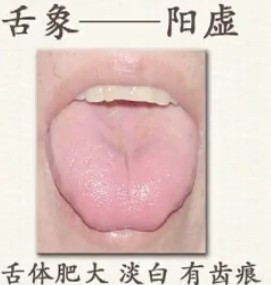
(1) Physical manifestations: Sensitivity to cold, preference for hot drinks, lack of energy, excessive sleep, pale lips, hair loss, excessive sweating, loose stools, clear and frequent urination. (2) Causes: Excessive consumption of cold medicines, cold drinks, weak constitution, excessive exposure to cold environments. (3) Solutions: 20 grams of Dang Gui (Angelica), 30 grams of Sheng Jiang (Fresh Ginger), 500 grams of lamb, boil into soup and consume.
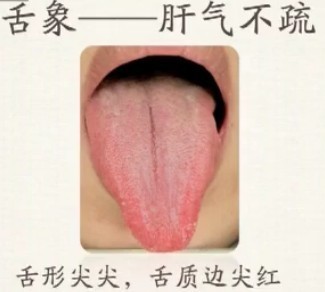
(1) Physical manifestations: Depression, bitter and dry mouth, dizziness, poor appetite, alternating chills and fever, irritability, nausea, chest tightness and rib pain, insomnia with vivid dreams. (2) Causes: Heavy thinking, high stress (emotional injuries: joy disperses Qi, anger raises Qi, worry gathers Qi, thinking knots Qi, sadness disperses Qi, fear lowers Qi, shock disrupts Qi). (3) Solutions: 3 grams each of Deng Xin Cao (Juncus), Zhu Ye (Bamboo Leaves), steep in water and drink for 3-5 days, mainly used for sudden heat requiring liver Qi regulation. Long-term liver Qi stagnation requires adjustment of the seven emotions: joy, anger, worry, thought, sadness, fear, and shock. Compassion is the most powerful tool to control the seven emotions, as the benevolent live long. Tongue Diagnosis: Organ Correspondence Chart
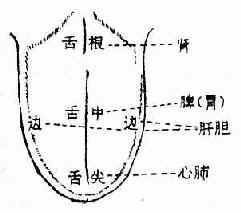
Tongue diagnosis organ correspondence chart (1) Tongue color: ① Pale tongue: The tongue color is lighter than normal, indicating deficiency or cold syndrome, often seen in blood deficiency, representing weak Yang Qi and insufficient Qi and blood. A pale and plump tongue indicates deficiency cold; a plump tongue with teeth marks on the edges indicates Qi deficiency or Yang deficiency. ② Red tongue: The tongue color is deeper than normal, bright red, indicating heat syndrome, often seen in interior heat excess. A red tip indicates heart fire; red edges indicate liver and gallbladder heat; a dry red tongue indicates heat injuring body fluids or Yin deficiency heat. ③ Dark red tongue: The tongue color is deep red, indicating excess heat, often seen in evil heat penetrating the nutrient level, blood level, or Yin deficiency heat. The deeper the red or dark color, the heavier the heat evil. ④ Stasis spots on the tongue: The tongue has blue-purple stasis spots, indicating internal blood stasis accumulation. ⑤ Blue-purple tongue: The entire tongue appears blue-purple, indicating extreme heat or cold syndrome. A dark red and dry tongue indicates extreme heat, while a pale yellow-purple or blue-purple and moist tongue indicates Yin cold syndrome. (2) Tongue shape: Observe the tongue’s texture, thickness, prickles, cracks, etc. ① Old and young: “Old” refers to a rough tongue texture, firm color, often indicating excess or heat syndrome; “young” refers to a delicate tongue texture, soft color, often indicating deficiency or deficiency cold syndrome. ② Thick and thin: “Thick” refers to a swollen tongue, often related to water retention. A pale and thick tongue with teeth marks often indicates spleen deficiency or kidney Yang deficiency, water retention; a red and swollen tongue often indicates internal damp-heat or excessive heat toxin. “Thin” refers to a thin and small tongue, often indicating deficiency syndrome. A pale and thin tongue often indicates Qi and blood deficiency; a red and dark thin tongue often indicates Yin deficiency internal heat. ③ Prickles: The tongue papillae are enlarged and protruding like thorns, often indicating excessive heat evil. The heavier the heat evil, the larger and more numerous the prickles. Clinically, prickles are often seen on the tip and edges of the tongue, with prickles on the tip often indicating excessive liver and gallbladder heat. ④ Cracks: The tongue has various longitudinal or transverse cracks or wrinkles, often due to mucosal atrophy. Cracked tongues can be seen in a few normal individuals. A red and cracked tongue often indicates excessive heat; a pale and cracked tongue often indicates Qi and Yin deficiency. (3) Tongue state: Observe whether the tongue trembles, is crooked, weak, or stiff. ① Trembling: The tongue trembles involuntarily, often indicating both Qi and blood deficiency or internal liver wind. ② Crooked: The tongue is tilted to one side, often indicating stroke or stroke precursor. ③ Weak: The tongue is weak and unable to extend, often due to both Qi and blood deficiency causing lack of nourishment to the muscles and veins. ④ Stiff: The tongue is not flexible, difficult to extend, or even unable to move, often indicating high fever injuring body fluids, excessive heat, or a sign of stroke. 2. Tongue coating: The tongue coating is a manifestation of the stomach’s vital energy. Zhang Xugu said: “The tongue coating arises from the stomach’s vital energy, and the stomach’s energy arises from the heart and spleen, so healthy individuals often have a thin coating, which is the stomach’s vital energy, like the fine grass on the ground; if there is no grass, the soil has no vitality.” Wu Kun’an said: “The tongue coating is like the moss on the ground. The ground’s moss arises from the upward diffusion of moisture; the tongue’s coating arises from the stomach steaming the spleen’s moisture, hence it is called coating.” Modern physicians believe that the formation of tongue coating is mainly due to the differentiation of filiform papillae. The tips of the filiform papillae differentiate into keratinized trees, and the gaps in the keratinized tree branches are often filled with shed keratinized epithelium, saliva, bacteria, food debris, and exuded white blood cells, forming normal tongue coating. Normal tongue coating is a thin white layer, tender and not thick, with moderate dryness and moisture, neither slippery nor dry. Observing the tongue coating involves examining the color, thickness, and moisture of the coating. (1) Coating color: There are white, yellow, gray, and black coatings. ① White coating: White coating is the most common in clinical practice, and other colors of coating can be considered transformations from white coating. White coating generally belongs to the lungs, indicating exterior syndrome or cold syndrome, but in clinical practice, white coating can also be seen in interior syndrome or heat syndrome. For example, thin white and moist indicates wind-cold; thin white and dry indicates wind-heat; cold damp interior syndrome can see thick and greasy white coating. ② Yellow coating: There are light yellow, tender yellow, deep yellow, and scorched yellow. Generally, the deeper the yellow coating, the heavier the heat evil. Light yellow indicates mild heat; tender yellow indicates heavier heat; deep yellow indicates even heavier heat; scorched yellow indicates heat accumulation; dry yellow indicates heat injuring body fluids; greasy yellow indicates damp-heat. ③ Gray-black coating: Often indicates heat syndrome, but can also indicate cold damp or deficiency cold syndrome. Gray-black and dry coating indicates excessive heat injuring body fluids; gray-black and moist coating often indicates Yang deficiency and excessive cold. Gray-black coating is often seen in more severe stages of illness. (2) Thickness: There are thin coating, thick coating, little coating, and no coating. Thin coating often indicates the initial stage of illness, with the evil in the exterior, and the condition is relatively mild; thick coating often indicates that the evil is more severe and has penetrated inward; or there is gastrointestinal accumulation; or phlegm dampness. The thicker the coating, the more severe the evil, and the more serious the condition. However, the formation of tongue coating reflects the presence of stomach Qi; even if the coating is thick, it indicates that stomach Qi is still present, while little coating often indicates insufficient righteous Qi, and no coating indicates severe deficiency of stomach Qi, lacking the ability to generate. Irregular tongue coating shedding, with smooth areas without coating, is called “flowered coating,” often indicating insufficient stomach Qi and Yin; if accompanied by greasy coating, it indicates that phlegm dampness has not transformed and righteous Qi has been injured. (3) Moisture and dryness: Reflects the condition of body fluids. Normal tongue coating is neither dry nor wet; dry tongue without coating indicates that body fluids have been consumed; external pathogens often cause dry heat injuring body fluids, while internal injuries often indicate Yin deficiency and insufficient body fluids; moist tongue coating indicates that body fluids have not been injured, while excessive moisture on the tongue surface that drips when extended is called “slippery coating,” indicating that there is dampness retained in the body. Greasy coating: The coating is dense and fine, like a layer of turbid, smooth mucus covering the tongue surface, difficult to wipe off, often indicating internal phlegm dampness. Putrid coating: The coating is loose like tofu dregs, piled on the tongue surface, easy to wipe off, often indicating that excessive heat has vaporized the food stagnation in the stomach, representing the putrefaction of food in the stomach. Explanation of Tongue Manifestation Atlas 1. Normal tongue manifestation: The tongue is light red, of moderate thickness, with thin white coating that is moist and appropriately dry. 2. Pale white tongue manifestation: The tongue is pale white, plump, with thin white coating. Significance: Often indicates weak stomach Qi or insufficient Qi and blood. 3. Old tongue with rough coating manifestation: The tongue is light red, old, with white coating covering, slightly yellow, rough like sand. Significance: Dampness obstructing the meridians, fluids not ascending, or excessive heat injuring fluids. 4. Pale white tongue with white coating manifestation: The tongue is pale white, with white coating covering, thick in the middle like accumulated powder. Significance: Yang deficiency with floating heat, can be seen in Yang deficiency with external damp-heat. 5. Pale white tongue with gray and dry coating manifestation: The tongue is pale white, plump, with gray-black dry cracks in the coating. Significance: Spleen failing to transport, damp turbidity not transforming, phlegm dampness obscuring the clear orifices. 6. Light red mirror tongue manifestation: The tongue is light red and tender, with cracks on the edges, the tongue surface is smooth and without coating, like a mirror. Significance: Insufficient stomach Yin or both Qi and Yin deficiency. 7. Stasis spots tongue manifestation: The tongue is light red and dark, with stasis spots and stasis patches, with thin white coating. Significance: Blood stasis obstructing the meridians, Qi and blood stagnation. 8. Pale red flowered peeled tongue (geographic tongue) manifestation: The tongue is light red, with a crooked body, white greasy coating with shedding, presenting a geographic pattern. Significance: Both Qi and Yin deficiency of the stomach, phlegm dampness obstructing the meridians. 9. Red tongue with flowered peeled coating manifestation: The tongue is red and tender, with white greasy flowered coating, shedding areas are smooth and without coating, or covered with white transparent coating. Significance: Damp-heat injuring Yin, damp turbidity not transforming, has already injured Yin fluids. 10. Red swollen tongue manifestation: The tongue is red, swollen, plump, unable to retract into the mouth, with yellow coating on the tip and middle, and white coating on the edges and root. Significance: Damp-heat steaming, blood heat obstructing. 11. Pale red purple stasis tongue manifestation: The tongue is pale red, with multiple blue-purple patches on the tip and edges, with uneven white greasy coating, and little coating in the middle. Significance: Qi stagnation and blood stasis or prolonged illness causing Qi and blood not to be replenished. 12. Pale red tongue with thick greasy coating manifestation: The tongue is pale red, with thick greasy white coating. Significance: Qi deficiency and blood stasis, phlegm and fluid accumulation. 13. Pale red tongue with thick putrid greasy coating manifestation: The tongue is pale red, slightly plump, with thick putrid greasy coating covering the tongue surface like accumulated powder, with a slight yellowish surface. Significance: Damp-heat obstructing the three burners. 14. Pale red tongue with yellow rough coating manifestation: The tongue is pale red, with yellow dry coating, rough like sand. Significance: Stomach and intestinal heat accumulation with dampness, damp-heat transforming into dryness. 15. Red tongue with black greasy coating manifestation: The tongue is red, with thick greasy coating, white and yellow on the edges, and black in the middle. Significance: Floating Yang deficiency, internal damp-heat. 16. Red tongue without coating manifestation: The tongue is red and tender, with cracks in the middle, except for a little remaining coating on the edges, the rest is smooth and without coating. Significance: Injury to both stomach and kidney Qi and Yin. 17. Teeth-marked tongue manifestation: The tongue is slightly red, plump with teeth marks, with longitudinal cracks in the middle, thin white coating with coarse and loose granules. Significance: Spleen deficiency with damp stagnation, with internal heat. 18. Cracked tongue manifestation: The tongue is slightly thin, with mostly longitudinal cracks like knife cuts, thin white coating. Significance: Often indicates Yin deficiency, true Yin insufficient, and deficiency fire rising. 19. Cracked tongue manifestation: The tongue is pale white with a blue-purple hue, plump, with deep cracks, and knife-like cracks on the edges, with uneven white greasy coating. Significance: Both Qi and blood are declining, kidney Yin insufficient. 20. Red tongue with white putrid coating manifestation: The tongue is red, with thick white coating, coarse and loose, like tofu dregs piled on the tongue surface. Significance: Phlegm and food accumulation, damp-heat steaming. 21. Red tongue with yellow putrid coating manifestation: The tongue is red, with red spots, the tongue body is old, the coating has transformed from white to gray-yellow, thick and putrid, with horizontal and vertical cracks. Significance: Damp-heat and turbid accumulation in the interior. 22. Dark red tongue with scorched yellow coating manifestation: The tongue is red but dark, with scorched yellow coating like a pot bottom, thick and cracked. Significance: Stomach and intestinal heat accumulation, obstructing the bowel Qi. 23. Red tongue with yellow and white coating manifestation: The tongue is red, with red spots, the coating is yellow and white, thick and covering, like rice flour. Significance: Evil heat and damp toxins accumulating in the interior. 24. Dark red tongue with scorched yellow and dry coating manifestation: The tongue is dark red and dull, the tongue body is thin, with thick scorched yellow and dry cracks in the coating. Significance: Excess heat and dryness accumulating in the stomach and intestines. 25. Red dark tongue with yellow-black coating manifestation: The tongue is dark red, old, with red spots on the tip, the coating is thin white transforming to gray-yellow, with gray-black filth at the root. Significance: Wind-phlegm disturbing, phlegm-heat obstructing the bowels. 26. Red dark tongue with black rough coating manifestation: The tongue is dark red, with red spots, black rough cracked coating covering, thick and accumulated. Significance: Internal heat toxin, phlegm-heat obstructing the bowels. 27. Red dotted prickled tongue manifestation: The tongue is red, with red dotted prickles, white greasy coating, slightly yellow on the surface. Significance: Nutrient level stagnation heat. 28. Blue-purple thin tongue manifestation: The tongue is thin and small, appearing blue-purple and dull, with thick putrid coating. Significance: Cold dampness stagnating, Qi and blood obstructing. 29. Dark red tongue with smooth peeled coating manifestation: The tongue is dark red and purple, with a smooth surface and no coating. Significance: Heat affecting the nutrient blood, injuring Yin and obstructing the meridians. 30. Pale white tongue with slippery coating manifestation: The tongue is pale and plump, with white slippery coating on the edges and tip, with yellow coating in the middle, thick and greasy. Significance: Kidney Yang deficiency; damp turbidity transforming into heat. 31. Red dark thin tongue manifestation: The tongue is dark red, thin and long, with two thick yellow coatings, dry and cracked into pieces, the rest is smooth and without coating. Significance: Stomach and intestinal heat accumulation injuring Yin and concurrently excessive Yin deficiency fire. 32. Red plump stasis tongue manifestation: The tongue is dark red with stasis spots, swollen tongue body, with damage on the tongue surface, white slippery coating with some brown. Significance: Internal damp toxin accumulation.
3. Precautions for Tongue Diagnosis
(1) The patient should naturally extend the tongue outside the mouth, fully exposing it, in a flat shape, allowing the tongue body to relax, without curling or excessive force, to avoid color changes. When observing the tongue, try to quickly and clearly see the tongue texture, body, and coating, avoiding the patient extending the tongue for too long; if necessary, a brief rest can be taken before re-observation. (2) The patient should face the light, allowing direct light to shine into the mouth, with sufficient light; otherwise, the color of the tongue texture and coating may be difficult to distinguish. (3) Pay attention to the influence of diet on tongue diagnosis: For example, after eating, the friction of food can make the tongue coating thinner; drinking can make the tongue coating moister; consuming warm or stimulating foods can make the tongue texture red or dark. Therefore, it is generally not advisable to perform tongue diagnosis immediately after the patient eats or rinses their mouth. (4) Be aware of staining: For example, drinking milk can make the coating appear white; eating plums, coffee, dried tangerine peel, olives, etc., can stain the tongue coating black or brown; eating fava beans, oranges, persimmons, and other foods can stain the tongue coating yellow. These temporary external stains should not be mistaken for pathological tongue coating. Appendix: Introduction to Modern Research on Tongue Diagnosis The tongue is one of the main organs in the oral cavity, composed of many transverse striated muscles, with a special mucous membrane on the surface, especially the dorsal mucosa, which is the main component of the tongue coating. The tongue has a rich distribution of blood vessels and nerves, and its mucosal epithelium is thin and transparent, thus it can sensitively reflect changes in the body, digestive system, and body fluids. In recent years, there has been an increasing number of studies using modern knowledge and methods to research TCM tongue diagnosis, summarized as follows: (1) Normal tongue manifestation: Light red tongue texture: Due to the rich blood vessels and blood circulation in the submucosa and muscular layer, the tongue muscle appears red, seen through a layer of white keratinized mucosal surface, forming a normal light red tongue texture. Thin white coating: Formed by the differentiation of the tips of the filiform papillae and the shed keratinized epithelium, saliva, bacteria, food debris, and exuded cells. (2) Changes in tongue manifestations: ① Changes in tongue texture are closely related to blood circulation, body fluid status, and physiological disorders, as well as metabolic disorders of tissue cells; for example, when the body’s compensatory function is disordered or insufficient, it may present a Qi deficiency tongue manifestation; when the body is excessively consumed, affecting the lack of certain important substances, it may present a Yin deficiency tongue manifestation. Pale white tongue is often related to tissue edema, capillary contraction, reduced blood volume, and slow blood flow, commonly seen in anemia or protein deficiency, especially albumin deficiency; it can also be seen in digestive system dysfunction or endocrine insufficiency, such as adrenal cortex insufficiency; red dark tongue is related to capillary dilation, increased blood volume, and blood concentration, often seen in fever, especially acute infectious diseases, dehydration, vitamin deficiency, post-surgery, water balance disorders, and coma patients; blue-purple tongue may be closely related to venous stasis or hypoxia leading to increased reduced hemoglobin, often seen in liver disease, heart disease, and cancer patients. A plump tongue is mainly due to reduced plasma protein, tongue tissue edema, and can appear with teeth marks on the edges due to edema, tongue enlargement, or reduced muscle tone and relaxation; cracks are caused by the fusion and separation of tongue papillae, possibly related to mucosal atrophy; prickles are due to the transformation of filiform papillae into fungiform papillae, while the blood vessels in the mucosal stroma become congested and dilated, causing the fungiform papillae to swell and become congested. A dry tongue texture is due to reduced saliva secretion or accompanied by decreased water content in saliva. In dehydrated patients, blood viscosity increases, and saliva secretion decreases, thus a dry tongue surface is the best indicator of clinical dehydration, being the earliest manifestation of dehydration caused by any reason. ② Changes in tongue coating are related to the proliferation of filiform papillae, increased keratinization, bacterial action, the amount of moisture in the oral cavity, and the nutritional status of the body, as well as organ diseases: white coating is often due to reduced oxygen exchange or anemia, leading to decreased oxygen transport, causing metabolic disorders of the tongue mucosa and increased metabolic products; yellow coating is due to the stimulation of inflammatory factors and metabolic products, causing the proliferation of filiform papillae, diffuse incomplete keratinization and excessive keratinization, along with keratin debris and the action of yellow microorganisms, as well as local inflammatory exudates on the tongue, thus often seen in infectious diseases, contagious diseases, fever, and some malignant tumors; black coating is formed due to more severe proliferation of filiform papillae, with brown keratinized cells and black mold growth, or putrefactive bacteria acting on necrotic substances on the tongue mucosa, or combining with iron-containing microorganisms to form iron sulfide, thus considered to be caused by chronic infections, toxic stimulation, gastrointestinal dysfunction, fungal infections, long-term use of antibiotics, and deterioration of oral health due to malignant diseases, and can also be seen in excessive smoking and poor oral hygiene. Thick and greasy tongue coating is often due to reduced appetite after illness or consumption of soft food, liquid, and reduced mechanical friction on the tongue, or due to fever and dehydration, reduced saliva secretion, and decreased cleaning action, affecting the tongue’s self-cleaning ability, leading to the elongation of filiform papillae, along with the accumulation of keratin debris, exudates, etc. Based on current research data, changes in tongue manifestations are related to the following points: ① Related to nutritional deficiencies: Patients with chronic gastric diseases or chronic diarrhea, due to poor digestion and absorption, can clinically see yellow or gray tongue coating. Excessive consumption and metabolic disorders can also lead to significant changes in tongue coating, such as various febrile patients initially having thin white coating, and in the middle stage, often having dry yellow coating; diabetic patients may present with dry red coating, etc. ② Related to the quality and quantity of the circulatory system and blood: Patients with severe anemia often have pale white tongues, with atrophied tongue papillae; dehydration, acidosis, blood concentration, and hypoxia often present with bright red or purple tongues; thrombocytopenia may show purple spots on the tongue; pernicious anemia may present with smooth tongues. ③ Related to bacterial and viral infections and the body’s resistance: In the early stages of epidemics, there is often white greasy coating, and in more severe or serious cases, red dark tongues; sepsis caused by Pseudomonas aeruginosa often presents with smooth peeled tongues, while sepsis caused by Streptococcus and Staphylococcus often presents with yellow coating. This indicates that changes in tongue manifestations are not only related to the type of bacteria but may also be related to the body’s resistance and reactivity. Generally, sepsis caused by Pseudomonas aeruginosa often occurs in cases where the body’s resistance is extremely poor, with insufficient righteous Qi, thus presenting smooth peeled tongues, while sepsis caused by Streptococcus and Staphylococcus infections often presents with heat syndrome, thus mostly showing yellow coating. ④ Related to saliva: Patients with high fever, such as those with toxic pneumonia and acute enteritis, often have dry tongues and loss of moisture in the oral cavity. This is due to increased blood viscosity and decreased watery saliva secretion. Also, in Yin deficiency patients, there is often increased sympathetic nervous tension and decreased parasympathetic nervous tension, leading to reduced serous saliva secretion, replaced by mucous secretion, resulting in changes in the quality of saliva and dry tongue surfaces. ⑤ Related to endocrine: Patients with endocrine disorders may have abnormal tongue manifestations, such as those with adrenal insufficiency may have brown raised or depressed pigment spots on the tongue. (3) Clinical significance of changes in tongue manifestations: ① Changes in tongue manifestations can reflect the severity and progression of diseases: For example, light red tongue texture, thin white, moist coating indicates a relatively mild condition; red dark tongue, blue-purple, yellow thick, gray-black, or smooth peeled tongue indicates a more severe condition; pale white tongue often belongs to chronic diseases, with slow changes and longer course, such as anemia, protein deficiency, or adrenal cortex insufficiency; red dark tongue is often seen in fever, dehydration, and water balance disorders, such as burn patients, the larger the burn area, the faster and more obvious the tongue texture turns red; if complicated with sepsis, the tongue texture often becomes red dark and dry, while liver cirrhosis patients whose tongue was originally pale red with thin white or thin yellow coating, once it turns red dark and smooth peeled, often indicates liver function deterioration; acute appendicitis often presents with greasy coating, during treatment, if thick greasy coating turns into thin white coating, it often indicates improvement, but if pain decreases while greasy coating does not retreat, it indicates that the condition has not improved, and may even worsen. ② Changes in tongue manifestations have certain significance for the diagnosis of some diseases: Sepsis caused by Pseudomonas aeruginosa often presents with smooth peeled tongues, while sepsis caused by Streptococcus and Staphylococcus often presents with yellow coating; severe infectious diseases, malignant tumors, hyperthyroidism, and severe diseases of solid organs such as the lungs, liver, and kidneys often present with red dark tongue, small tongue body, dry tongue with cracks, indicating Yin deficiency tongue manifestations; some tongue coatings may present smooth peeled tongues with red prickles on the tip, while in the later stages, the tongue surface may be smooth like a mirror; severe hepatitis patients often present with red dark tongues, dry and lacking moisture, with more obvious deterioration of the condition, while the tongue coating may often be thick greasy or dry, yellow or black, and sometimes smooth peeled tongues without coating can also be seen; late-stage tumor patients may present with red and shiny tongue manifestations. Tongue Diagnosis Mnemonics (1) Tongue and coating, first must distinguish; coating is residue, tongue is essence. Coating reflects Qi disease, tongue reflects blood disease; Yin and Yang, exterior and interior, cold and heat, deficiency and excess. The depth of evil can be discerned from the coating; the deficiency and excess of organs can be recognized from the tongue texture. (2) Changes in tongue coating, each has its division: The tip corresponds to the heart and lungs, the center corresponds to the stomach and intestines, the root corresponds to the kidneys, the four sides correspond to the spleen and earth, the sides of the tongue correspond to the liver and gallbladder; there is another method, observing the three burners, the tip above and the root below, the middle corresponds to the middle burner. (3) Distinguishing tongue moisture, dryness, slippery, and rough. Moisture is normal, thick indicates dampness. Moist and abundant fluids, slippery coating indicates color. Rough and floating indicates dryness. Dryness indicates fluid depletion. (4) With spirit or without spirit, distinguished by flourishing or withering. Flourishing indicates moistness, fluids are abundant; red and bright indicates rich Qi and blood. Withering indicates lack of blood color. Righteous Qi is about to deplete, fluids are deficient and dry, indicating a critical condition. (5) Red tongue indicates heat, with many distinctions. Heart fire rising, red at the tip. Red on the edges indicates liver and gallbladder heat. Early stage of warm disease, often red at the tip and edges; seen in various diseases, heart and liver colors; headache, insomnia, irritability, and constipation. Bright red also has its distinctions; severe heat in warm diseases, various diseases with Yin deficiency. Dry red at the heart indicates Yin fluids being robbed. Smooth and tender without moisture indicates mirror tongue; often indicates severe conditions, fluids are depleted. If Qi and blood are deficient, pale red tongue texture. (6) Dark red and deep red indicate warm heat transmission. Pure dark red and bright indicate excessive heat. Dry and withered. Depleted kidney Yin; often seen with dry throat. Life is about to decline. There is also a type, dark red tongue with little coating, even cracks, indicating that Yin fluids are about to be exhausted. Dark red tongue with greasy coating, resembling coating but not coating, dampness and turbidity obstructing, fragrant and opening. Observing it appears abundant, feeling it has moisture, fluids have been injured, damp heat steaming, turbid phlegm obscuring orifices, clear fluids generating. (7) Purple tongue indicates disease, both Yang and Yin; with coating or without coating, mainly distinguished. Moisture and dryness, deep or light, full tongue or spots, indicate different diseases, varying in severity. Yellow coating with purple tongue indicates internal heat accumulation; accompanied by dryness, urgent need to purge. Blue-purple tongue with floating coating indicates early stage of cold damage. Blood stasis diseases, purple tongue and dull, generally slippery, or with gray coating, heavier indicates full tongue, lighter indicates spots; prolonged pain entering the meridians, similar to this. Alcoholics often have purple spots on the tongue. Center white and slippery, after drunkenness, cold damage. Purple tongue swollen, alcohol toxicity is harmful, threatening the heart, life is difficult to save. (8) Blue changes, slightly like purple tongue; still able to produce coating, righteous Qi has not yet depleted. Bright blue without coating, color withered and not moist, indicates extreme danger, original Qi is exhausted. Blue not filling the tongue, indicates various conditions: epidemic filth, accompanied by powdery white coating; yellow greasy turbid coating, damp warmth and heat; slippery blue in the middle indicates damp phlegm tongue. (9) Black indicates severe illness, both Yin and Yang: tender, moist, indicates extreme cold; rough, dry, indicates extreme heat. Blood has decayed. In ancient times, it was called death sign. Accurate identification can lead to early rescue, or victory may be achieved. (10) Old and tender, also need analysis: Firm and old indicates excess heat obstruction, spirit still exists, often belongs to excess; swelling and deficiency also belong to phlegm dampness. Tender with teeth marks indicates weakness. (11) Cracks and prickles, each has its signs: Cracks in the tongue texture, almost like broken porcelain, blood deficiency and excessive heat, also seen in Yin deficiency. Peeling like shedding, a piece smooth, indicates Yin injury, often difficult to fill. More severe conditions, the entire tongue peels off. The tongue grows prickles, with black and yellow, regardless of front or back, indicates dryness. The tongue body is swollen, phlegm and damp heat. The tongue body is thin and shriveled, indicating various deficiency syndromes. (12) Soft and gentle, normal tongue texture, flexible movement, Qi and blood are mutually beneficial. Weak and dark indicates extreme deficiency, color appears pale red, Qi and blood are extremely deficient. The tongue body is stiff, wind, fire, and phlegm are different: stiff tongue indicates paralysis, heart and spleen wind entering; red and swollen indicates extreme heart fire; phlegm swelling and stiffness, coating gray. The tongue’s extension is usually smooth; if unable to extend, trembling indicates deficiency. The tongue desires to extend, the root is like a line pulling, there are three causes: dryness, cold, phlegm, all affect the muscles and veins, stiff tongue and speech difficulty. Dryness and cold urgency, wind phlegm adhesion. The tongue extends phlegm heat, paralysis indicates deficiency. Crooked to one side, indicates wind obstructing the meridians. Tongue twisting and licking lips, heart and spleen heat accumulation, often seen in children with convulsions. The tongue suddenly shortens, dry red indicates Yin damage; white moist indicates cold condensation; greasy indicates phlegm accumulation. (13) With root or without root, also needs distinction, related to the existence of Qi. Coating with root grows from the tongue, tightly adhering to the tongue surface, evenly spread. Coating without root, thick coating appears, surrounding is clean, like painted on the tongue surface. (14) Thick coating and thin coating, internal and external evils accumulate. Exterior cold is generally thin, with various symptoms; evil accumulation with thick coating, internal symptoms are often excess. Putrid coating is loose and thick, easily wiped off, indicating transformation of evil, Yang Qi is sufficient. Greasy indicates sticky tongue, scraping does not remove, phlegm dampness resides, Yang is obstructed by Yin. Putrid coating is like mold, or like rotten pus, indicating stomach Qi is decayed, or internal abscess. (15) Coating covering the tongue, evil Qi is scattered, exterior symptoms are thin white; white greasy belongs to phlegm, medication should be cautious, to prevent many changes. Coating grows unevenly, either in the middle or at the front, or left or right, requires careful examination. Coating color changes, can be traced: from white to yellow, yellow retreats to new, this is a favorable sign, evil resolves and righteousness prevails. White, yellow, gray, and black, gradually increasing, indicates that righteous Qi is insufficient, and the evil is deepening. If the coating suddenly retreats, not gradually transforming, the evil Qi has penetrated inward, indicating danger. (16) Food staining the coating, attention must be paid to distinguish. Loquats and olives can turn yellow or black. Sweet, sour, and salty foods, colored juices can stain the coating, often making the tongue appear white and moist. (17) White coating indicates exterior, and damp deficiency cold. White and slippery coating indicates external wind-cold. White coating with red tongue indicates initial wind-warm infection. White coating with dark base indicates dampness obstructing heat. White greasy coating indicates internal phlegm dampness. Moist white coating, with teeth marks and plump tongue, indicates phlegm dampness. Deficiency syndrome with white coating appears clear, often tender and smooth, indicating Yang deficiency. (18) Yellow coating indicates disease, belonging to interior and heat. Slightly yellow and not dry indicates initial transmission; yellow and dry indicates extreme internal heat. Yellow coating accumulation indicates Yangming bowel excess. Dryness leading to black prickles, or cracks, indicates deep heat, Yin fluids have disappeared. Yellow and slippery greasy indicates phlegm dampness heat accumulation. The above yellow coating generally indicates heat excess. Another type, light and loose flower color, yellow and light, plump tongue texture, moist and cool, indicates spleen deficiency with dampness.

